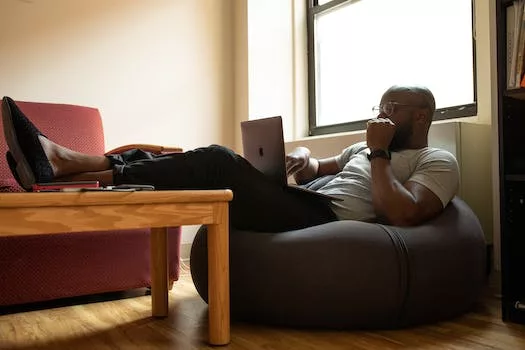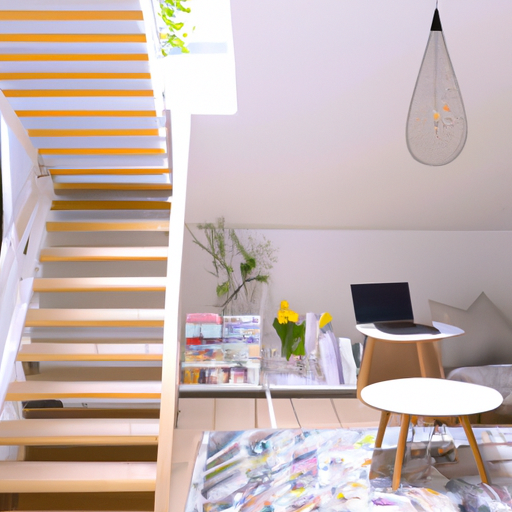Creating a Functional Home Office Space in Modern Complex Designs
In recent years, the concept of working from home has gained significant traction, with more and more people opting for flexible work arrangements. This shift in work culture has led to an increased demand for modern complexes that cater to the needs of remote workers. Designing a modern complex that is perfect for working from home requires a thoughtful approach, taking into consideration the various elements that contribute to a functional and comfortable home office space. In this article, we will explore some key factors to consider when designing a modern complex that is ideal for remote work.
First and foremost, it is essential to create a dedicated workspace within the complex. This space should be separate from the living and sleeping areas, allowing residents to maintain a healthy work-life balance. A well-designed home office should be equipped with all the necessary amenities, such as a comfortable desk and chair, ample storage, and proper lighting. Natural light is particularly important, as it not only helps to reduce eye strain but also contributes to overall well-being. Therefore, incorporating large windows or skylights in the design of the home office space is highly recommended.
In addition to natural light, the overall layout and design of the home office should promote productivity and focus. This can be achieved by minimizing distractions and creating a clutter-free environment. One way to do this is by incorporating built-in storage solutions, such as shelves and cabinets, which can help keep the workspace organized and tidy. Additionally, the use of neutral colors and minimalistic design elements can contribute to a calming atmosphere, allowing residents to concentrate on their work.
Another crucial aspect of designing a modern complex for remote work is ensuring that the space is equipped with the necessary technology infrastructure. This includes reliable high-speed internet access, as well as ample power outlets and charging stations for various devices. It is also worth considering the inclusion of smart home features, such as voice-activated assistants and automated lighting systems, which can help streamline daily tasks and improve overall efficiency.
Acoustic considerations are also important when designing a modern complex for remote work. With more people working from home, it is essential to minimize noise disturbances and ensure that residents can work in a quiet and peaceful environment. This can be achieved by incorporating soundproofing materials and techniques in the design of the complex, such as double-glazed windows, insulated walls, and acoustic panels. Additionally, the layout of the complex should be designed in such a way that the home office spaces are located away from high-traffic areas and potential noise sources, such as elevators and communal spaces.
Finally, it is important to consider the overall well-being of residents when designing a modern complex for remote work. This includes providing access to outdoor spaces, such as balconies, terraces, or gardens, which can help to alleviate stress and promote relaxation. Additionally, incorporating communal amenities, such as fitness centers, lounges, and co-working spaces, can help to foster a sense of community and provide opportunities for social interaction.
In conclusion, designing a modern complex that is perfect for working from home requires a thoughtful approach that takes into consideration the various elements that contribute to a functional and comfortable home office space. By creating a dedicated workspace, promoting productivity and focus, ensuring access to necessary technology infrastructure, minimizing noise disturbances, and considering the overall well-being of residents, designers can create a modern complex that caters to the needs of remote workers and contributes to a healthy work-life balance.
Integrating Work-Life Balance Features in Contemporary Residential Complexes

In recent years, the concept of working from home has gained significant traction, with more and more professionals opting for flexible work arrangements. This trend has been further accelerated by the global pandemic, which has forced many businesses to adopt remote work policies. As a result, there is a growing demand for residential complexes that cater to the needs of work-from-home professionals. In this article, we will explore the key features that should be integrated into modern residential complexes to create the perfect environment for working from home.
One of the most important aspects of designing a residential complex for work-from-home professionals is ensuring that there is ample space for a dedicated home office. This space should be separate from the living and sleeping areas, allowing residents to maintain a healthy work-life balance. Ideally, the home office should be located in a quiet part of the complex, away from communal areas and potential noise disturbances. It should also be equipped with essential office amenities such as a comfortable desk, ergonomic chair, and ample storage space for documents and office supplies.
In addition to a dedicated home office, it is crucial to provide residents with access to high-speed internet and reliable communication infrastructure. This will enable them to stay connected with their colleagues and clients, attend virtual meetings, and complete their work tasks efficiently. To achieve this, residential complexes should invest in fiber-optic internet connections and ensure that Wi-Fi coverage is available throughout the complex, including outdoor spaces.
Another essential feature for a work-from-home-friendly residential complex is the availability of shared workspaces and meeting rooms. These spaces can be used by residents who need a change of scenery or who require a more formal setting for meetings with clients or colleagues. Shared workspaces should be equipped with comfortable seating, ample desk space, and access to power outlets for charging electronic devices. Meeting rooms should be available for booking by residents and should be equipped with video conferencing facilities, whiteboards, and other essential meeting amenities.
Incorporating green spaces and outdoor areas into the design of a residential complex can also greatly enhance the work-from-home experience. Access to nature has been proven to boost productivity, reduce stress, and improve overall well-being. Therefore, modern residential complexes should include landscaped gardens, rooftop terraces, or balconies that provide residents with a peaceful outdoor environment where they can take breaks, relax, or even work outdoors when the weather permits.
To further promote a healthy work-life balance, residential complexes should also offer a range of leisure and wellness facilities. These may include fitness centers, swimming pools, and sports courts, allowing residents to stay active and maintain a healthy lifestyle. Additionally, communal spaces such as lounges, game rooms, and cafes can provide opportunities for social interaction and relaxation, helping to prevent feelings of isolation that can sometimes accompany remote work.
Finally, it is important to consider the location of the residential complex in relation to essential amenities and services. Proximity to grocery stores, pharmacies, and healthcare facilities can greatly enhance the convenience and overall quality of life for work-from-home professionals. Additionally, easy access to public transportation and major roadways can facilitate occasional commutes to the office or client meetings.
In conclusion, designing a modern residential complex that is perfect for working from home requires careful consideration of various factors, including dedicated home office spaces, reliable communication infrastructure, shared workspaces, access to nature, leisure facilities, and proximity to essential amenities. By integrating these features into contemporary residential complexes, developers can cater to the growing demand for work-from-home-friendly living environments and promote a healthy work-life balance for residents.
Innovative Architectural Solutions for Remote Work in Modern Living Spaces
In recent years, the concept of working from home has gained significant traction, with more and more people opting for remote work as a viable alternative to traditional office-based jobs. This shift in work culture has led to a growing demand for modern living spaces that cater to the unique needs of remote workers. As a result, architects and designers are now faced with the challenge of creating innovative architectural solutions that seamlessly integrate work and living spaces, while ensuring maximum comfort, functionality, and productivity. In this article, we will explore some key considerations and design strategies for creating a modern complex that is perfect for working from home.
One of the most important aspects of designing a modern complex for remote work is the efficient use of space. With the lines between work and personal life becoming increasingly blurred, it is essential to create distinct zones within the living space that cater to different activities. This can be achieved by incorporating flexible and multi-functional furniture, such as fold-out desks, modular seating, and convertible storage solutions. These elements not only help to maximize the available space but also allow residents to easily switch between work and leisure modes, depending on their needs.
Another crucial factor to consider when designing a modern complex for remote work is the provision of ample natural light and ventilation. Studies have shown that exposure to natural light can significantly improve productivity, mood, and overall well-being. Therefore, it is essential to incorporate large windows, skylights, and open floor plans that allow for maximum daylight penetration and air circulation. Additionally, the use of light-reflecting materials and finishes can further enhance the sense of spaciousness and brightness within the living space.
Connectivity is also a key consideration when designing a modern complex for remote work. With the increasing reliance on technology for communication and collaboration, it is essential to ensure that residents have access to high-speed internet and reliable Wi-Fi connections. This can be achieved by incorporating advanced wiring systems and dedicated workstations with built-in charging ports and cable management solutions. Additionally, the inclusion of smart home technology, such as voice-activated assistants and remote-controlled lighting and temperature systems, can further enhance the overall convenience and functionality of the living space.
In addition to these practical considerations, it is also important to create a sense of community and social interaction within the modern complex. This can be achieved by incorporating shared amenities and communal spaces, such as co-working lounges, meeting rooms, and outdoor terraces. These spaces not only provide residents with opportunities to network and collaborate with fellow remote workers but also help to foster a sense of belonging and camaraderie within the complex.
Finally, it is essential to consider the overall aesthetic and ambiance of the modern complex. A well-designed living space should not only be functional and efficient but also visually appealing and inspiring. This can be achieved by incorporating a cohesive color palette, high-quality materials, and contemporary design elements that reflect the unique needs and preferences of remote workers. Additionally, the inclusion of greenery and biophilic design elements can further enhance the overall sense of well-being and productivity within the living space.
In conclusion, designing a modern complex that is perfect for working from home requires a careful balance of practical considerations and aesthetic appeal. By incorporating innovative architectural solutions that cater to the unique needs of remote workers, such as efficient space utilization, ample natural light, and advanced connectivity, architects and designers can create living spaces that not only support productivity and well-being but also foster a sense of community and belonging. With the continued growth of remote work, it is essential for the design industry to adapt and evolve in order to meet the changing needs of modern living.
Q&A
Question 1: What are the essential features to include in a modern complex designed for working from home?
Answer 1: A modern complex designed for working from home should include dedicated workspaces or home offices, high-speed internet connectivity, soundproofing for noise reduction, ample natural lighting, ergonomic furniture, shared amenities like meeting rooms and co-working spaces, and green outdoor spaces for relaxation and rejuvenation.
Question 2: How can the design of a modern complex promote work-life balance for residents working from home?
Answer 2: To promote work-life balance, the design should incorporate separate zones for work and leisure, provide access to fitness and wellness facilities, create communal spaces for social interaction, and integrate nature through landscaped gardens and outdoor recreational areas.
Question 3: What are some sustainable design elements that can be incorporated into a modern complex for working from home?
Answer 3: Sustainable design elements include energy-efficient building materials and systems, solar panels for renewable energy generation, green roofs and walls to reduce heat gain, rainwater harvesting systems, waste management and recycling facilities, and the use of native plants in landscaping to support local biodiversity.
Conclusion
In conclusion, designing a modern complex that is perfect for working from home involves incorporating elements such as dedicated workspaces, soundproofing, ample natural light, ergonomic furniture, high-speed internet connectivity, and shared amenities like meeting rooms and recreational spaces. Additionally, prioritizing sustainability, green spaces, and a sense of community will enhance the overall living and working experience for residents.


